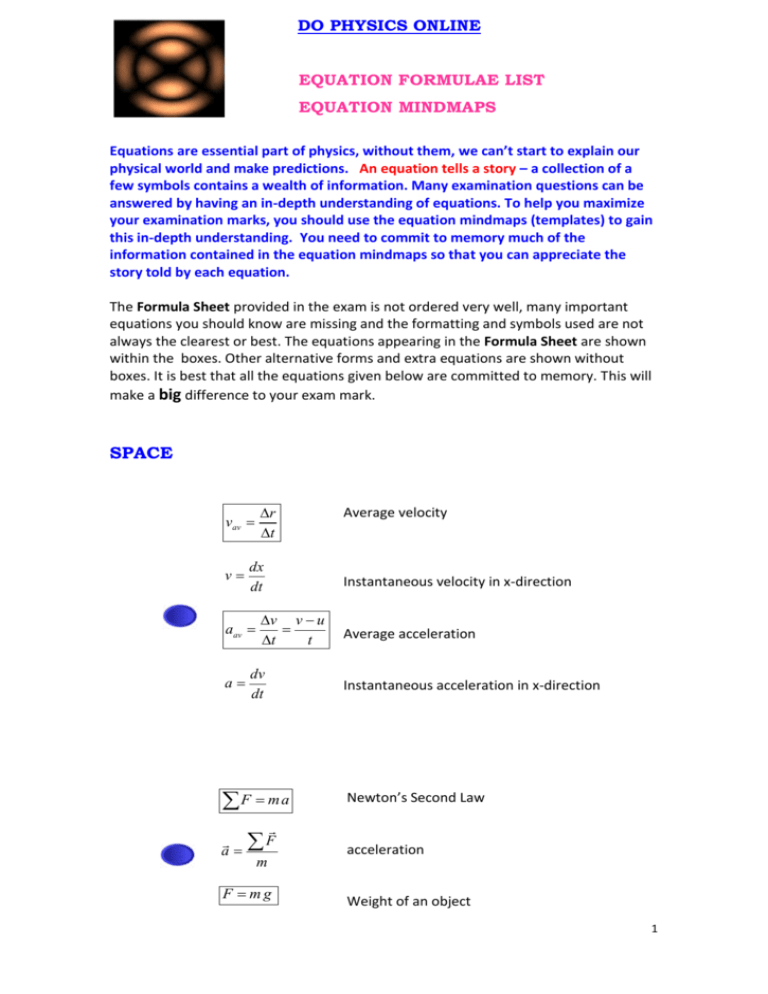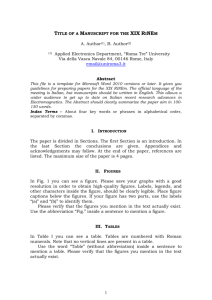equations
advertisement

DO PHYSICS ONLINE EQUATION FORMULAE LIST EQUATION MINDMAPS Equations are essential part of physics, without them, we can’t start to explain our physical world and make predictions. An equation tells a story – a collection of a few symbols contains a wealth of information. Many examination questions can be answered by having an in-depth understanding of equations. To help you maximize your examination marks, you should use the equation mindmaps (templates) to gain this in-depth understanding. You need to commit to memory much of the information contained in the equation mindmaps so that you can appreciate the story told by each equation. The Formula Sheet provided in the exam is not ordered very well, many important equations you should know are missing and the formatting and symbols used are not always the clearest or best. The equations appearing in the Formula Sheet are shown within the boxes. Other alternative forms and extra equations are shown without boxes. It is best that all the equations given below are committed to memory. This will make a big difference to your exam mark. SPACE vav v dx dt aav a r t v v u t t dv dt F ma a F m F mg Average velocity Instantaneous velocity in x-direction Average acceleration Instantaneous acceleration in x-direction Newton’s Second Law acceleration Weight of an object 1 F m v2 r Centripetal force: uniform circular motion F v2 ac c m r Centripetal acceleration g force ag g g-force (g = +9.8 m.s-2) g force FAB FBA Newton’s Third Law Frocket Fgases eg rocket propulsion p mv Momentum of a moving object impulse F t Impulse of a force F acting for a time interval t J F t m v m u Impulse = change in momentum F 0 p 0 Law of Conservation of momentum W Fs EK 12 m v 2 W F s 12 m v 2 12 m u 2 W qV 1 2 apparent weight m a m g normal weight mg m v 2 eV Work done by a force during a displacement Kinetic energy of a moving object Work done = change in KE Work done on a charge in an electric field Gain in KE electron due to a constant accelerating voltage 2 v u at s ut at 1 2 Equation for uniform accelerated motion in onedimension 2 v2 u2 2 a s a = constant uv vav 2 s vav t vx 2 ux 2 Equations for Projectile Motion v u at v y 2 u y 2 2 a y y x ux t y u y t 12 a y t 2 ux u cos motion in x-direction (horizontal) +x direction is positive ax 0 vx ux sx ux t u y u sin vy uy ay t s y u y t 12 a y t 2 vy2 uy2 2 ay sy motion in y-direction (vertical) +y direction is positive (vertically up) s sx s y 2 2 2 v 2 vx 2 v y 2 tan s tan v ay = - 9.8 m.s-1 sy sx vy vx 3 F G m1 m2 d2 F G m1 m2 r2 g planet Gravitational force G M planet E p G R planet Acceleration due to gravity at surface of a planet m1 m2 r Gravitational potential energy Gravitational potential energy near Earth’s surface Ep m g h g G ME G ME 2 2 r RE h Acceleration due to gravity (Earth) Period of pendulum g L T 2 g Kepler’s Third Law for satellite motion r 3 GM T 2 4 2 r13 r2 3 T12 T2 2 r13 r2 3 T12 T2 2 3 r 2 T2 T1 2 r1 vorb T GM r 2 r vorb vesc 2GM r orbital velocity orbital period geostationary satellite T = 24 hours escape velocity 4 E mc 2 lv l0 1 tv Equations of Einstein’s Special Relativity v2 c2 t0 v2 c2 m0 1 mv 1 v2 c2 5 Motors and Generators V I P V I Energy V I t Resistance F II k 1 2 l d Magnetic force between two parallel conductors F B I L sin Magnetic force on a conductor R B Electrical power Electrical energy 0 I 2 r Magnetic field surrounding a long straight conductor Fd n B I A cos Torque Torque on a coil in a magnetic field B B A cos Magnetic flux B t average induced emf dB dt induced emf B B A cos t t B A sin t electric motor: back emf back battery I R back Vp Vs Vs Transformer equation: step up or step down voltages np ns ns Vp np Ps Pp Ploss I 2 R Is np ns Ip Vs I s V p I p ideal transformer Power loss (eddy currents – transformer, induction heating; transmission lines) 6 From Ideas to Implementation F q v B sin E F q E V d Force on a charged particle moving in a magnetic field Electric field Electric field (constant) between two parallel charged plates Eh f Energy of a photon c f Speed of light Speed of electromagnetic radiation 1 2 m v 2 eV Gain in KE of electron due to accelerating voltage Photoelectric Effect h f 12 m v 2 W h f 12 m vmax 2 Wmin 1 2 m vmax 2 h f Wmin eVs 12 m vmax 2 Vs Stopping voltage h f Wmin e e eVs 12 m vmax 2 0 h f c Wmin n d sin Cut-off (critical) frequency W f c min h Bragg’s Law – crystal structure (constructive interference) 7 From Quanta to Quarks 1 1 R 2 2 n ni f Hydrogen atom - spectrum E2 E1 h f Bohr Model of atom 1 h 2 L mvr En n = 1, 2, 3, … Energy levels hydrogen atom r1 5.29 1011 m Allowed orbits for electrons in hydrogen atom de Broglie wavelength de Broglie relationship h mv Eh f E1 13.6 eV E1 n2 rn r1 n 2 Angular momentum quantized h p x p c f p h 4 h p h Photon Matter wave Heisenberg Uncertainty Principle 8 m M products M reactants Mass defect E m c2 Einstein – mass/energy 9 Be4 4 He2 12 C6 1 n0 Chadwick discovers neutron Beta plus decay p+ n + e+ + e Beta decay Pauli & Fermi neutrino 19Ne 10 19F 9 + e+ + e e+ + p[d(-1/3) u(+2/3) u(+2/3)] n[d(-1/3) u(+2/3) d(-1/3)] Beta minus decay n p e e 232 Th90 228 Ra 88 4 He2 4 Alpha decay He2 Standard model proton d (-1/2) u (+2/3) u (+2/3) Proton neutron d (-1/3) u (+2/3) d (-2/3) 235U + 1n 92 0 236U * 92 136Xe + 88Sr 56 36 Neutron matter wave Nuclear fission + 121n0 9








